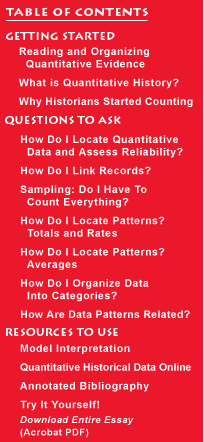talking history | syllabi | students | teachers | puzzle | about us
|
|
Although
record linkage sometimes involves trying to match large sets of data,
historians often use it in much more limited contexts. For example,
an 1880 newspaper article mentions that Terrence O’Malley and Hans
Normann were the leaders of a strike in a wire mill. Tracing O’Malley
and Normann into the City Directory and the manuscript census reveals
that they were neighbors, landowners, and American-born children of
immigrant parents. Such information helps us to understand the leadership
of the strike in ways that the newspaper article alone doesn’t.
Or, a 1910 newspaper account describes how the women of Delancey Street
(an immigrant neighborhood on Manhattan’s Lower East Side) organized
a protest against rising rents. Tracing those women into census and
tax records helps us to learn about their race, ethnicity, and occupations,
as well as the structure of their families. Most people assume that New York’s Central Park, the nation’s best-known urban landscape, was built on unoccupied land. In fact, about 1,600 people lived on part of the area that became Central Park in the late 1850s; their community was known as Seneca Village. One way to learn about these “pre-park” dwellers is to look at what both contemporaries and subsequent commentators had to say about them. Here are some excerpts: The
Park residents are “principally Irish families” living in
“rickety . . . little one storie shanties . . . . inhabited by
four or five persons, not including the pig and the goats.” The
land for Central Park is the “scene of plunder and depredations,”
“the headquarters of vagabonds and scoundrels of every description,”
and the location of “gambling dens, the lowest type of drinking
houses, and houses of every species of rascality.” The
park before construction was “the refuge of about five thousand
squatters, dwelling in rude huts of their own construction, and living
off the refuse of the city. . . .These people who had thus overrun and
occupied the territory were principally of foreign birth, with but very
little knowledge of the English language, and with very little respect
for the law. Like the ancient Gauls, they wanted land to live on, and
they took it.” The
park land was a “wilderness” filled with “the habitations
of poor and wretched people of every race and color and nationality,
[including] . . . many families of colored people with whom consorted
and in many cases amalgamated, debased and outcast whites. Many of the
inhabitants of this village had no regular occupation, finding it easy
to replenish their stock of fuel with driftwood from the river and supply
their tables from the same source, with fish.” Were the residents of the land that became Central Park described accurately by these quotes? Do the documents below support or contradict the descriptions above? To find out for yourself, search in the documents for evidence about Andrew Williams, one of the park residents. Does the evidence in these documents about Andrew Williams fit with the description of Seneca Village residents in the quotations? 1. Andrew Williams Affidavit of Petition, 1856 2. New York State Census, 1855 (Transcription of census page)
|
|||

|
||||



